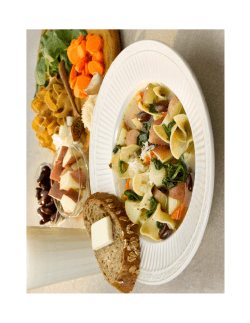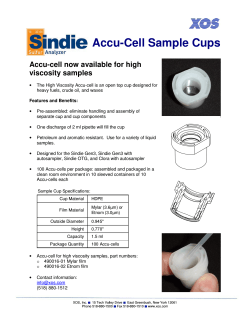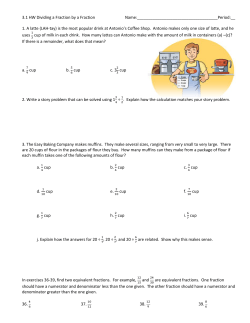
The Diabetes Cultural Food Plate Photographs: Cultural food on portion plates
The Diabetes Cultural Food Plate Eleanor Marfoglia and Lori Vinitski Merck Health Literacy Leader: Laurie Myers Program Goal Educational Intervention Educate patients with diabetes about how to use the portion plate method. Print Communication 1 2 1 4 1 4 l l l Program Objective l l l l Patients will understand how to divide the 9-inch plate1 l Clearly stated purpose Southern American Limited scope of content Patients will understand the portion, plate labels: nonstarchy vegetables, protein and starches. Greek Filipino Chinese l Created with a Dietician/Nutritionist Food plates photography printed at actual size Hawaiian Italian Indian Japanese l Translations available for ordering Mexican American Patients will recognize portion sizes Non-English – speaking patients will understand the portion plate Vegan Diet Spanish Vietnamese Digital Communication l l Digital execution in development The print communication was offered in a digital print ordering system The ordering system consists of 400 education resources Translations Available for food portion plates Patient Education Resources offered in Digital Print Orderi One year tracking results The cultural food plate was the most ordered resource for one year 400 Print Resources The portion plate method may help with weight management and glucose control.1 l Photographs: Cultural food on portion plates Customer Ordering The ordering system confirms that this resource is in demand by health educators l 1 2 F I R S T 1 4 1 4 P L A C E 1 Year Tracking Results 1. American Diabetes Association, Living Healthy with Diabetes Criteria to increase chance of success The program should be appropriate, culturally sensitive and meet the needs of the target audience.2 2. Bernard Healey, Robert S. Zimmerman Jr.The New World of Health Promotion: New Program Development, Implementation and Evaluation. The diabetes portion plate The diabetes portion plate Each item below is one serving Nonstarchy Vegetables • 1 cup raw or 1/2 cup cooked nonstarchy vegetables Whole Grains and Starches Meat and Meat Substitutes • 1 slice whole-grain bread • 1/2 to 3/4 cup dry unsweetened cereal • 1/2 cup corn or peas • 1/2 corn on cob, large • 1/3 to 1/2 cup cooked pasta or noodles • 1/3 cup brown or white rice • 1/4 bagel (1 ounce) • 2 to 5 low-fat crackers • 1/2 cup mashed potatoes or 1 small baked potato • 1 ounce fish, skinless chicken, or lean meat • 1/2 cup tofu • 1 egg • 1 tablespoon peanut butter • 1 ounce cheese A typical serving is about 15 grams carbohydrates and 80 calories* A typical serving is about 0 grams carbohydrates and 45–100 calories* Use your hand as a guide for measuring food portions fist = 8 ounces handful = 1/2 cup ¼ How to divide your plate Nonstarchy vegetables Fill 1/2 of your plate with nonstarchy vegetables, such as tomatoes, green beans, peppers, zucchini, artichoke, and broccoli. ¼ A typical serving is about 5 grams carbohydrates and 25 calories* Whole grains and starchy foods Fill 1/4 of your plate with grains and starchy foods, such as whole-grain breads, high-fiber cereal, brown rice, whole-grain pasta, and beans. Milk and Dairy Fats thumb = 1 ounce • 8-ounce cup fat-free or low-fat milk or fortified unsweetened plain soy milk • 2/3 cup plain fat-free or low-fat yogurt • 2/3 cup plain fat-free or low-fat yogurt with artificial sweetener • 1 teaspoon vegetable oil, margarine, mayonnaise, or butter • 1 tablespoon regular salad dressing • 2 tablespoons reduced-fat salad dressing • 3 tablespoons light sour cream • 10 small peanuts • 6 whole almonds or cashews fingertip = 1 teaspoon Fruits • 1 small fresh fruit • 1 cup cubed melon or raspberries • 1 large kiwi Protein Fill 1/4 of your plate with protein, such as skinless chicken, lean cuts of beef or pork, fish, shrimp, eggs, and tofu. Use oils that are low in saturated fat. Good choices are canola, peanut, and olive oil. (1 serving = 1 teaspoon) A typical serving is about 15 grams carbohydrates and 60 calories* ½ Provided as an educational resource by Merck Customer Logo Customer name MMMMMMMMMMMMMMMMMMMMMMMMMMMMMM Address second line Customer phone Merck Commitment The customer solutions team works with customers to help improve patient health outcomes through our expertise and innovative solutions A typical serving is about 12 grams carbohydrates and 90-150 calories* A typical serving is about 0 grams carbohydrates and 45 calories* *Read the food label for exact amount of carbohydrates, protein, fat, and calories. Talk with your health care team about your individualized meal plan. Use a 9-inch plate. Copyright © 2011 Merck Sharp & Dohme Corp., a subsidiary of Merck & Co., Inc. All rights reserved. Printed in USA Minimum 10% Recycled Paper The diabetes portion plate for an American meal English-GX DIAB-1000438-0000 08/11 (order reference#) DIAB-1081433-0000 05/13
© Copyright 2025











